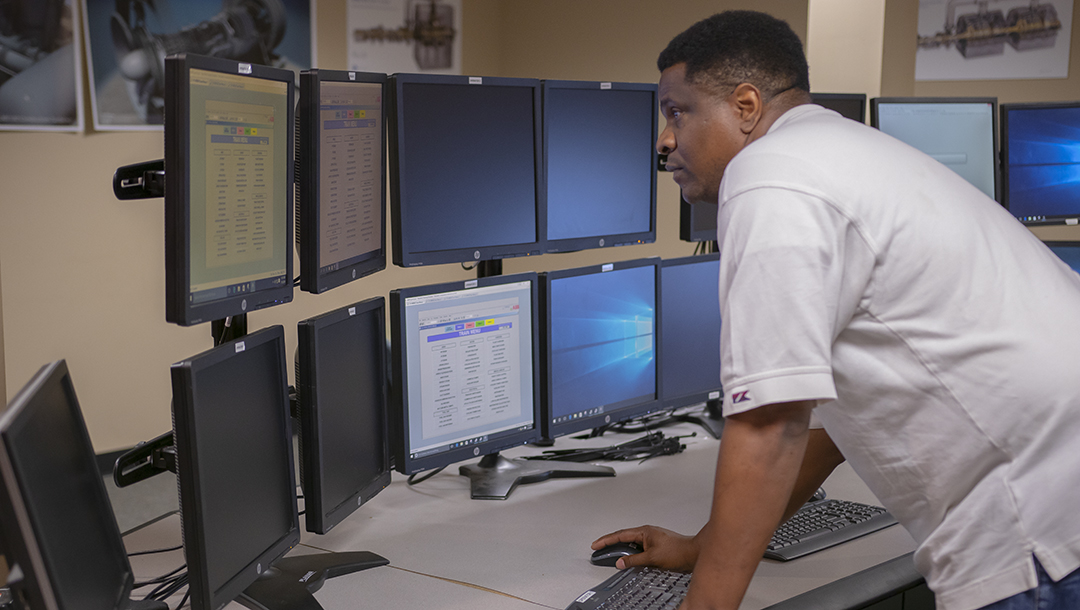
OSU Institute of Technology recently received a donation of a power plant simulator from Oklahoma Gas & Electric to aid in the training of students in the Power Plant Technology program.
The simulator was installed in a power plant classroom that will serve as a mock control room. The room also contains a control room horseshoe, a series of cabinets that form a u-shaped control center, donated by industry.
“A PPS is a tool that industry uses to advance employees skill sets,” said Terry Hanzel, Power Plant instructor. “It can be compared to a flight simulator used for pilots.”
This type of set up allows students in the program to sit in front of four to eight computer monitors and navigate through procedures and screens with a mouse. As the student makes adjustments to the equipment on the screen, they document their settings in a logbook, which in a power plant, is considered a legal document. In the mock control room, the simulator is like a multi screen educational video.
“After the control system was updated at OG&E’s Redbud Power Plant, the company saw an opportunity for a control room simulator to help us build our workforce,” said Robert Doupe, OG&E Redbud Power Plant director. “We engaged the instructors at OSUIT and decided to donate the simulator to advance the school’s program.”
This isn't the first simulator the program has had. Hanzel said that a couple of years back they gained access to some grant money through the OSUIT Workforce & Economic Development and were able to purchase what would be classified as a generic simulator. He said it is a great learning tool, but it is limited in capabilities. This new simulator will provide more opportunity for students to learn.
“This is a state-of-the-art simulator,” Doupe said. “Instructors have the opportunity to simulate actual events that a power plant control room operator would see in the real world. It can also be used to teach systems to students and how everything ties together.”
This simulator is a high definition actual plant model. It is a model of a specific plant that is one of the largest Natural Gas Combined Cycle Plants in the OG&E fleet. The turbine used at this plant is one of the most common turbines used through all of the plants in Oklahoma.
“When our students learn to start up and operate this simulator, they will be familiar with the real operations of many plants.,” said Hanzel. “This simulator is so realistic that we will be able to build in decision-making situations.”
“For example, the instructor can have a pump burn up 10 minutes into the process. Audible alarms will go off and the screens will start flashing. There is great satisfaction in getting a plant up and running; it is a real calculated process. When alarms go off and you have to start working your way through screens to diagnose the issue and make corrections before something blows up or the plant trips offline, it is a real adrenaline rush. This communicates the value of this tool to the industry.”
Molly Peters, OG&E director of Workforce Planning and Development, said that OG&E believes strongly in doing their part to help advance STEM education in our state and help to build a strong state workforce.
“Our partnership with OSUIT not only develops a pipeline of future OG&E workers, but also energy industry and manufacturing plant workers,” she said. “These collaborations spur growth and economic opportunities in our communities and in our state.”
OG&E said that the majority of their lineman and power plant interns are from OSUIT.
“OG&E has a long-standing relationship with OSUIT,” said Donnie Jones, vice president of Power Supply Operations. “Several OG&E employees serve on the Power Plant Technology Advisory Board and various power plant employees have supported classroom instruction on specific topics/tasks that are utilized within a power plant. In addition to the training simulator, OG&E has supported OSUIT with other equipment donations for the power generation program such as cabinets, controls devices, pumps and valves.”
Hanzel said this will aid students and employees in learning cause and effect situations without any real damage to plant equipment or loss of revenue.
“A huge thank you to OG&E for this donation,” said Hanzel.
